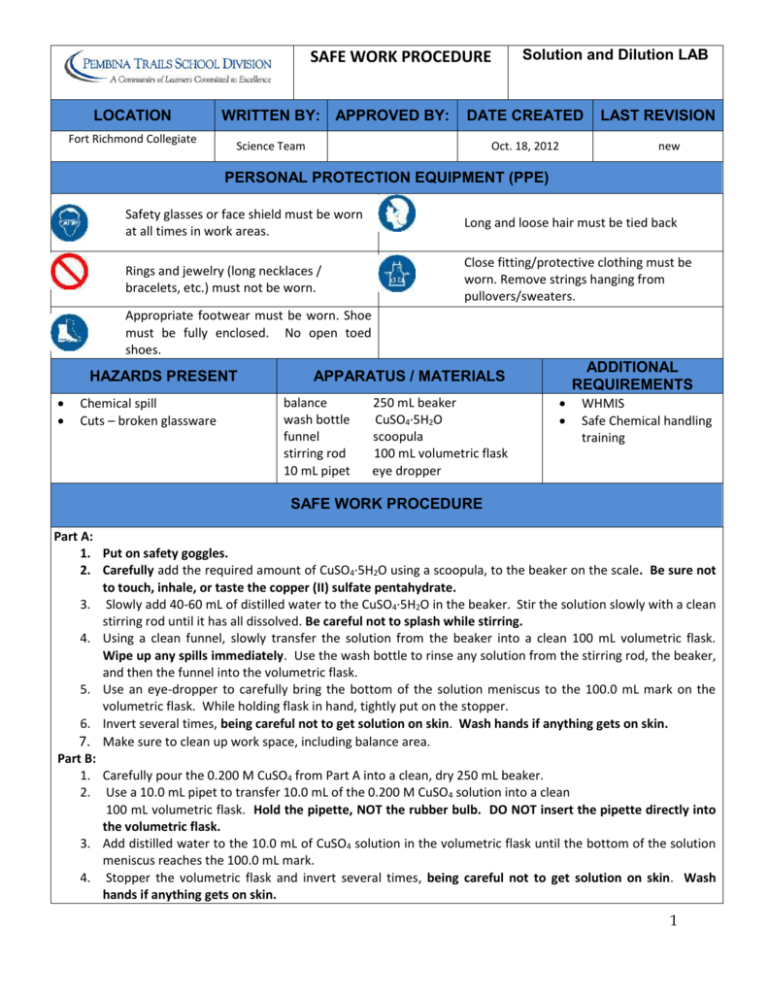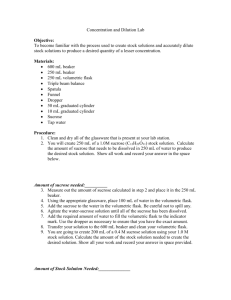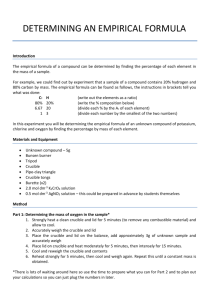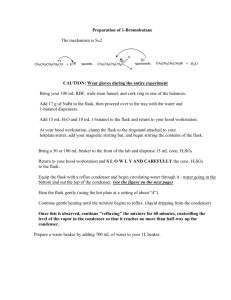Solution Preparation & Dilution Lab Procedure
advertisement

SAFE WORK PROCEDURE LOCATION Fort Richmond Collegiate WRITTEN BY: APPROVED BY: Solution and Dilution LAB DATE CREATED Science Team Oct. 18, 2012 LAST REVISION new PERSONAL PROTECTION EQUIPMENT (PPE) Safety glasses or face shield must be worn at all times in work areas. Long and loose hair must be tied back Rings and jewelry (long necklaces / bracelets, etc.) must not be worn. Close fitting/protective clothing must be worn. Remove strings hanging from pullovers/sweaters. Appropriate footwear must be worn. Shoe must be fully enclosed. No open toed shoes. HAZARDS PRESENT Chemical spill Cuts – broken glassware ADDITIONAL REQUIREMENTS APPARATUS / MATERIALS balance wash bottle funnel stirring rod 10 mL pipet 250 mL beaker CuSO4∙5H2O scoopula 100 mL volumetric flask eye dropper WHMIS Safe Chemical handling training SAFE WORK PROCEDURE Part A: 1. Put on safety goggles. 2. Carefully add the required amount of CuSO4∙5H2O using a scoopula, to the beaker on the scale. Be sure not to touch, inhale, or taste the copper (II) sulfate pentahydrate. 3. Slowly add 40-60 mL of distilled water to the CuSO4∙5H2O in the beaker. Stir the solution slowly with a clean stirring rod until it has all dissolved. Be careful not to splash while stirring. 4. Using a clean funnel, slowly transfer the solution from the beaker into a clean 100 mL volumetric flask. Wipe up any spills immediately. Use the wash bottle to rinse any solution from the stirring rod, the beaker, and then the funnel into the volumetric flask. 5. Use an eye-dropper to carefully bring the bottom of the solution meniscus to the 100.0 mL mark on the volumetric flask. While holding flask in hand, tightly put on the stopper. 6. Invert several times, being careful not to get solution on skin. Wash hands if anything gets on skin. 7. Make sure to clean up work space, including balance area. Part B: 1. Carefully pour the 0.200 M CuSO4 from Part A into a clean, dry 250 mL beaker. 2. Use a 10.0 mL pipet to transfer 10.0 mL of the 0.200 M CuSO4 solution into a clean 100 mL volumetric flask. Hold the pipette, NOT the rubber bulb. DO NOT insert the pipette directly into the volumetric flask. 3. Add distilled water to the 10.0 mL of CuSO4 solution in the volumetric flask until the bottom of the solution meniscus reaches the 100.0 mL mark. 4. Stopper the volumetric flask and invert several times, being careful not to get solution on skin. Wash hands if anything gets on skin. 1 5. Walking, take the final solution to your teacher. REGULATORY REQUIREMENTS WS&H Act W210, Section 4, 5 Mb. Regulations 217/2006, Part 16, (Machines / Tools & Robots) Sections 16.1-16.18) Part 35, (WHMIS Application) Part 36, (Chemical & Biological Substances Application) 2 Lab: Preparation of a Standard solution and Dilution of a Known Solution Purpose: A: To accurately prepare a solution of known concentration. B: To subsequently dilute the solution prepared in Part A. Prelab Exercise: Calculate the mass of copper (II) sulphate pentahydrate (CuSO4∙5H2O(s)) required to prepare 100.0mL of a 0.200 mol/L solution. Apparatus: balance CuSO4∙5H2O stirring rod eye dropper 250 mL beaker funnel 100 mL volumetric flask wash bottle (distilled water) scoopula 10 mL pipet Procedure: Part A: 1. Place a clean, dry 250 mL beaker on the scale, reset the scale to zero, and add the required amount of CuSO4∙5H2O as calculated in the prelab exercise. 2. Add 40-60 mL of distilled water to the CuSO4∙5H2O in the beaker. Stir the solution with a clean stirring rod until it has all dissolved. 3. Using a clean funnel, transfer the solution from the beaker into a clean 100 mL volumetric flask. Ust the wash bottle to rinse any solution from the stirring rod, the beaker, and then the funnel into the volumetric flask. 4. Use an eye-dropper to carefully bring the bottom of the solution meniscus to the 100.0 mL mark on the volumetric flask. Stopper the volumetric flask and invert several times. Part B: Proceed with the following steps to dilute the CuSO4 solution from Part A. 5. Pour the 0.200 M CuSO4 from Part A into a clean, dry 250 mL beaker. 6. Use a 10.0 mL pipet to transfer 10.0 mL of the 0.200 M CuSO4 solution into a clean 3 100 mL volumetric flask. 7. Add distilled water to the 10.0 mL of CuSO4 solution in the volumetric flask until the bottom of the solution meniscus reaches the 100.0 mL mark. 8. Stopper the volumetric flask and invert several times. 9. Take the final solution to your teacher who will check it for colour intensity and/or conductivity against a set of standard solutions. (Be sure to have labelled your flask). Observations: Mass of copper (II) sulphate pentahydrate required: ________________ Calculate the concentration of the solution after the dilution. Questions: 1. What property of the copper (II) sulphate solution changes noticeably upon dilution? 2. The original and diluted solution will react with zinc metal. Predict which solution would react with zinc at a faster rate? Why? 3. Which solution would contain a greater number of moles of solute, 8.00 mL of the concentrated copper (II) sulphate, or 40.0 mL of the diluted solution? Show calculations. 4. Can a 0.2000 mol/L solution be prepared using the equipment employed in this lab? 4







